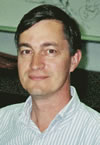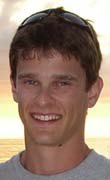Today
10 a.m.
Environmental Energy Technologies
A Computationally Efficient Approach using Detailed Chemical Kinetics in Multidimensional Simulation of HCCI and PCCI Engine Combustion
Dan Flowers, LLNL
Bldg. 70-191
Noon
Yoga Club
Class with Naomi Hartwig
Bldg. 70-191
Noon
Dance Club
Practice Session
Bldg. 51 Lobby
Monday
Noon
Dance Club
Free Lessons
Bldg. 51 Lobby
1:30 p.m.
Benefits Office
Passport to Retirement Workshop - Part 1 (BLI 1703)
George Noceti, Morgan Stanley
Perseverance Hall
1:30 p.m.
EHS 155
Building Manager/BET Seminar
Bldg. 50 Auditorium
3:50 p.m.
Nuclear Engineering
What is Reactivity? How Modern Core Analysis Methods Advanced Physics Test Measurement Methods
Yung-An Chao, Westinghouse Electric
3105 Etcheverry (campus)
4 p.m.
Chemistry Department
Chromatin Structure Control
Karolin Luger, Colorado State U.
100 Lewis Hall (campus)
4:30 p.m.
Physics Department
An Observationalist Take on Dark Energy: The Return of the Optimists
Saul Perlmutter
1 LeConte (campus) |
|
 |
|
|
 |
|
| |
Breakfast: Pineapple Pancakes with Bacon
Carvery: Sonora Spice Rub Roasted Chicken served with Two Sides
Pizza: Sundried Tomato and Artichoke
Deli: Cuban Panini
Grill: Turkey Pastrami Reuben with French Fries
Cultural Cuisine: California Burrito Bar
| B'fast: |
6:30
a.m. - 9:30 a.m. |
| Lunch: |
11
a.m. - 1:30 p.m. |
Full
menu  |
| |
|
|
|
 |
|
 |

'Twilight Zone' Recycles
Carbon in the Ocean
|
|
|
|
 |
 |
|
|
| Bishop |
|
|
|
The VERTIGO Project, reported in today's Science, was led by Woods Hole Oceanographic Institution scientists with collaborators including Jim Bishop of Berkeley Lab's Earth Sciences Division. VERTIGO shows that phytoplankton near the ocean surface absorb CO2 from the atmosphere, but much of it is recycled by animals and bacteria in the "Twilight Zone," limiting the ocean's ability to store atmospheric carbon. Near Hawaii, only 20 percent of carbon gets through the Twilight Zone. "The biological carbon pump of the NW Pacific is stronger and more efficient," says Bishop, passing 50 percent, which he suspects is due to increased subsurface iron. Full story.

Peta Computing's
Parallel Universe
By Gordy Slack
Researchers with the Center for Information Technology Research in the Interest of Society (CITRIS) will soon have access to petascale computers. These parallel machines may employ more than a million processors and will be able to handle huge data sets. With the delivery of a new petascale computer to Berkeley Lab, researchers working on climate analysis, genomics, environmental monitoring, protein analysis, earthquake, nanoscience, and other CITRIS-related fields will gain access to powerful new modeling tools. James Demmel and Katherine Yelick, both with the Lab's Computational Research Division, are quoted in the article. Full story.

|
 |
|
 |
Avoiding Rattlesnakes
While Out on the Trail
As temperatures warm, rattlesnakes come out of hibernation. Most remain inactive and out of sight, but become more visable when migrating in the spring and fall. To prevent snakebites in both humans and pets, become familiar with local species. Keep rattlesnakes out of home and garden by removing potential rodent and snake nesting sites. While hiking, keep pets on a leash, stay on trails and avoid areas of tall grass, rocks or woodpiles. More information can be found here.
 |
 |
|
 |
 |

Bill Boosting Science,
Math Skills Passes Senate
By Joel Havemann
Congressional Democrats and Republicans have found something they agree on — boosting U.S. technological prowess by improving science and mathematics instruction from kindergarten through graduate school and assisting researchers early in their careers. The competitiveness bills grew out of a 2005 report by the National Academies. The study — which Lab Director Steve Chu helped develop — warned that the U.S. could lose its competitive edge to other nations if it didn't make a concerted effort to improve the quality of the nation's mathematicians, scientists and engineers. Full story.

|
 |
|
 |
Radiation Protection
Award for Lab Scientist
|
|
|
|
 |
 |
|
|
| Durbin |
|
|
|
At the annual meeting of the National Council on Radiation Protection and Measurement (NCRP) in Arlington, VA, on April 16, Patricia Durbin of the Chemical Sciences Division was honored as the NCRP's 31st Lauriston S. Taylor lecturer. Her lecture, "The Quest for Therapeutic Actinide Chelators," concerned chemicals that sequester and remove from the body such elements as plutonium. Durbin was selected for the Taylor lectureship, the NCRP's highest award, for her scientific contributions to the field of actinide chemistry and biology, her commitment to radiation protection, and her 50 years of service to the NCRP. For more on Durbin's NCRP award, go here.
Materials Sciences Grad Student Receives Honor
|
|
|
|
 |
 |
|
|
| Wilcox |
|
|
|
Berkeley Lab Materials Sciences Division graduate student James Wilcox recently received the Daniel Cubicciotti Award from the Electrochemical Society's San Francisco chapter. The award was established in 1994 to assist a deserving student in Northern California to pursue a career in the physical sciences or engineering. Wilcox will receive a plaque and $2,000 for educational assistance. Wilcox's advisors are Lut DeJonghe and Marca Doeff, both with Materials Sciences.

|
 |
|
|
 |
|
|
|
|
 EMERGENCY INFO EMERGENCY INFO |
 |
Emergency: Call x7911
Cell Phones: Call 911
Non-emergency Incident Reporting: Call x6999
SECON level 3
More Information |
 |
|
|
 |
|
|

